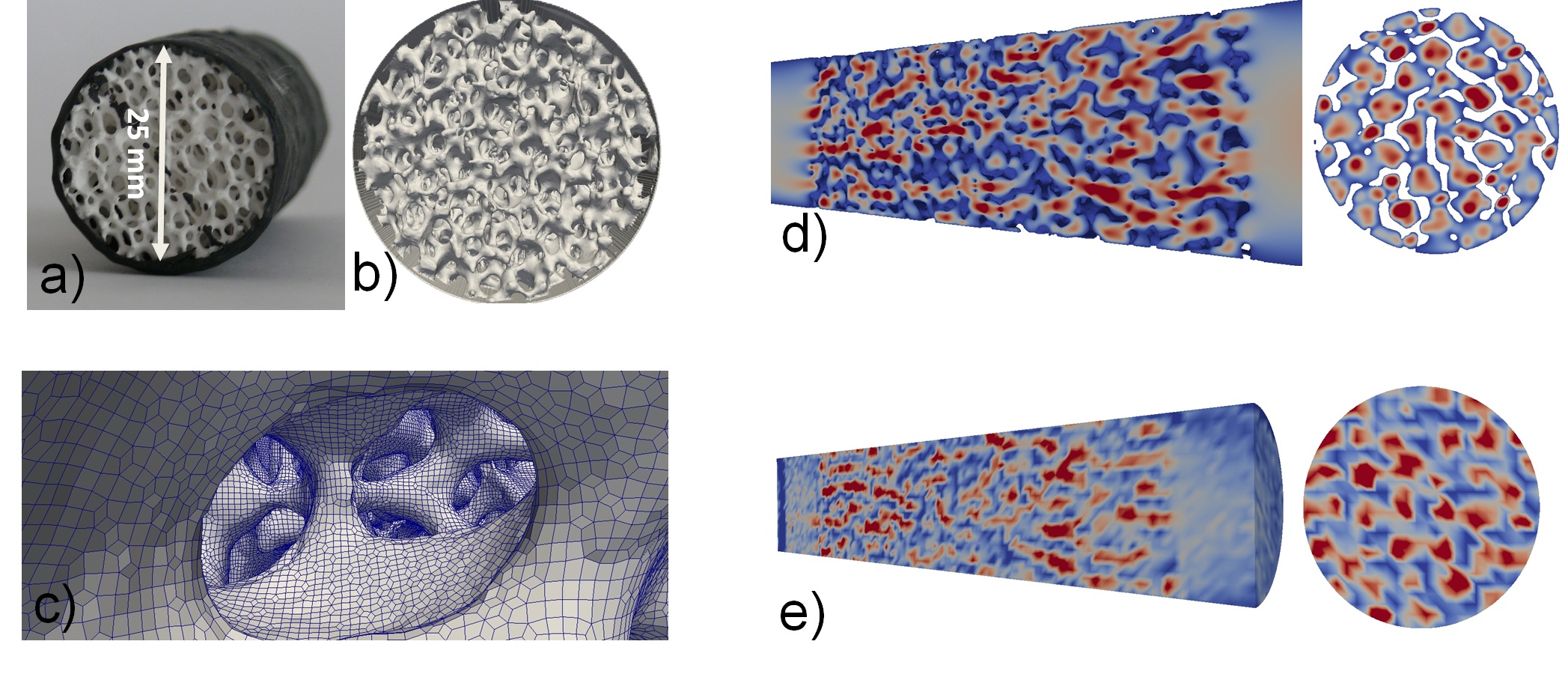Mass transport in graded monolithic catalyst supports for strong exothermal gas phase and multiphase reactions
Open-cell foams, also known as solid sponges, haves exceptional properties such as large porosity, high permeability, high volumetric surface area and advantageous conductive heat transport. These properties suggest sponges as a promising option for monolithic catalyst support of highly exothermic reactions such as methanation and Fischer-Tropsch synthesis (FTS). These reactions play an important role in power-to-gas and power-to-liquid technology, and any improvement of their performance might contribute to the success of the Energiewende. Aim of the project is the understanding of the underlying principles of mass transport in graded monolithic catalyst supports in case of strongly exothermal multiphase reactions like FTS. Computational fluid dynamic tools (CFD) are used to simulate two-phase flows on the sample scale (25 mm in diameter) and on the pore scale down to micrometers. This is achieved by means of x-ray tomography of the samples and conversion of data into machine-readable files(with P 04/03, P 09/03, and P 10/03) for meshing and modelling (Fig. 1). Simulations on the pore scale provide flow pattern (Fig. 2) and reveal properties of the porous media, such as equivalent pore diameter and the permeability. Here, we hypothesize that graded sponge porosities allow for significant intensification of heat transport and that CFD simulations can reveal the underlying relationships even in case of multiphase flows and reactions. In order to obtain sufficient reliability, CFD simulations (with P07/03) will be validated by magnetic resonance imaging (MRI) measurements in strong cooperation with Dr. Dreher’s group (P03/03). In this respect, we hypothesize that gaseous phase MRSI is also possible in case of (a) higher temperatures and (b) multiphase reactions. We assume that measures can be found to overcome the expected challenges of low signal to noise ratios. In order to describe the influence of monoliths with graded porosity on mass transfer in case of multiphase flows and reactions, additional CFD simulations will be performed that are based on virtually graded sponges. Here gradations will be used that result from optimisation calculations.

Fig. 1: a) Uncoated sponge; b) Reconstruction of a porous sample from x-ray tomography data; c) Meshing to be used in computational fluid dynamics, d) Numerical simulation of gas flow in a real porous structure; e) flow pattern within the same sponge measured using magnetic resonance imaging.
Publications within MIMEMIMA:
Kiewidt, L. and Thöming, J., 2018. Pareto-optimal design and assessment of monolithic sponges as catalyst carriers for exothermic reactions. Chemical Engineering Journal. https://doi.org/10.1016/j.cej.2018.11.109Mirdrikvand, Mojtaba, Jan Ilsemann, Jorg Thöming, and Wolfgang Dreher. "Spatially Resolved Characterization of the Gas Propagator in Monolithic Structured Catalysts Using NMR Diffusiometry." Chemical Engineering & Technology 41, no. 9 (2018): 1871-1880.
Ulpts, J., Kiewidt, L., Dreher, W., Thöming, J. (2018). 3D characterization of gas phase reactors with regularly and irregularly structured monolithic catalysts by NMR imaging and modeling. Catalysis Today 310, 176-186.
Ulpts J, Dreher W, Kiewidt L, Schubert M, Thöming J (2016) In situ analysis of gas phase reaction processes within monolithic catalyst supports by applying NMR imaging methods. Catalysis Today 273, 91-98
Ulpts J, Dreher W, Klink M, Thöming J (2015) NMR imaging of gas phase hydrogenation in a packed bed flow reactor. Applied Catalysis A, General 502, 340-349. Kiewidt L, Thöming J (2015) Predicting optimal temperature profiles in single-stage fixed-bed reactors for CO2-methanation. Chemical Engineering Science, 132, 59-71.


